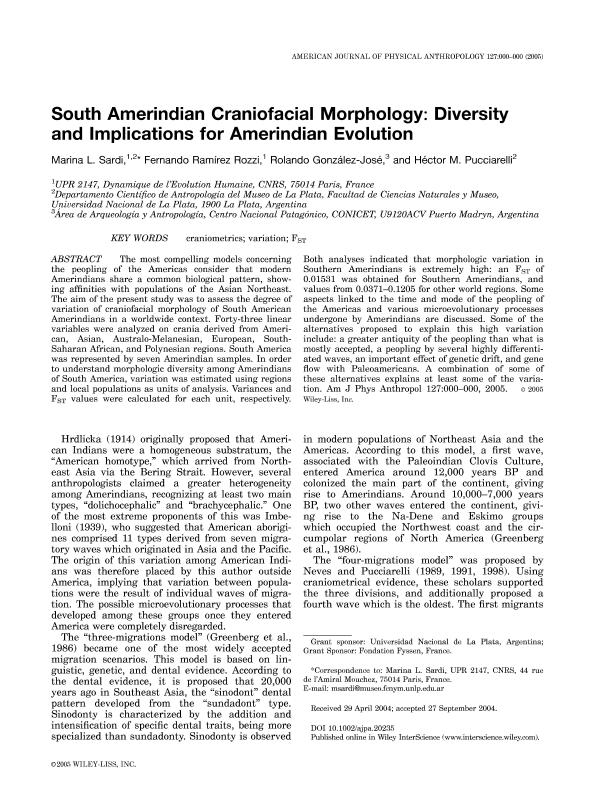Artículo
South Amerindian craniofacial morphology: Diversity and implications for Amerindian evolution
Sardi, Marina Laura ; Ramirez Rozzi, Fernando Victor; González José, Rolando
; Ramirez Rozzi, Fernando Victor; González José, Rolando ; Pucciarelli, Hector Mario
; Pucciarelli, Hector Mario
 ; Ramirez Rozzi, Fernando Victor; González José, Rolando
; Ramirez Rozzi, Fernando Victor; González José, Rolando ; Pucciarelli, Hector Mario
; Pucciarelli, Hector Mario
Fecha de publicación:
12/2005
Editorial:
Wiley-liss, Div John Wiley & Sons Inc
Revista:
American Journal Of Physical Anthropology
ISSN:
0002-9483
e-ISSN:
1096-8644
Idioma:
Inglés
Tipo de recurso:
Artículo publicado
Clasificación temática:
Resumen
The most compelling models concerning the peopling of the Americas consider that modern Amerindians share a common biological pattern, showing affinities with populations of the Asian Northeast. The aim of the present study was to assess the degree of variation of craniofacial morphology of South American Amerindians in a worldwide context. Forty-three linear variables were analyzed on crania derived from American, Asian, Australo-Melanesian, European, South- Saharan African, and Polynesian regions. South America was represented by seven Amerindian samples. In order to understand morphologic diversity among Amerindians of South America, variation was estimated using regions and local populations as units of analysis. Variances and FST values were calculated for each unit, respectively. Both analyses indicated that morphologic variation in Southern Amerindians is extremely high: an FST of 0.01531 was obtained for Southern Amerindians, and values from 0.0371–0.1205 for other world regions. Some aspects linked to the time and mode of the peopling of the Americas and various microevolutionary processes undergone by Amerindians are discussed. Some of the alternatives proposed to explain this high variation include: a greater antiquity of the peopling than what is mostly accepted, a peopling by several highly differentiated waves, an important effect of genetic drift, and gene flow with Paleoamericans. A combination of some of these alternatives explains at least some of the variationST values were calculated for each unit, respectively. Both analyses indicated that morphologic variation in Southern Amerindians is extremely high: an FST of 0.01531 was obtained for Southern Amerindians, and values from 0.0371–0.1205 for other world regions. Some aspects linked to the time and mode of the peopling of the Americas and various microevolutionary processes undergone by Amerindians are discussed. Some of the alternatives proposed to explain this high variation include: a greater antiquity of the peopling than what is mostly accepted, a peopling by several highly differentiated waves, an important effect of genetic drift, and gene flow with Paleoamericans. A combination of some of these alternatives explains at least some of the variation.
Palabras clave:
craniometrics
,
variation
,
FST
Archivos asociados
Licencia
Identificadores
Colecciones
Articulos(CCT - LA PLATA)
Articulos de CTRO.CIENTIFICO TECNOL.CONICET - LA PLATA
Articulos de CTRO.CIENTIFICO TECNOL.CONICET - LA PLATA
Articulos(CCT-CENPAT)
Articulos de CTRO.CIENTIFICO TECNOL.CONICET - CENPAT
Articulos de CTRO.CIENTIFICO TECNOL.CONICET - CENPAT
Citación
Sardi, Marina Laura; Ramirez Rozzi, Fernando Victor; González José, Rolando; Pucciarelli, Hector Mario; South Amerindian craniofacial morphology: Diversity and implications for Amerindian evolution; Wiley-liss, Div John Wiley & Sons Inc; American Journal Of Physical Anthropology; 128; 4; 12-2005; 747-756
Compartir
Altmétricas



